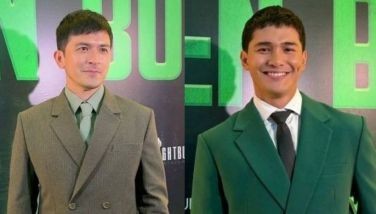Bocelli's Christmas wish fulfilled - a MET debut
MANILA, Philippines - There is no end to Andrea Bocelli fever as shown by another Christmas release called My Christmas, another recording brainchild of “hitman” David Foster.
As usual, the Christmas favorites are in this CD such as Adeste Fideles, White Christmas and Silent Night.
But to make this CD not just another reprise of previous recordings, the “hitman” assembled guest singers the likes of Welsh mezzo Katherine Jenkins who joins him in I Believe while Mary J. Blige blends with him in What Child Is This?
Bocelli is also soloist of the Mormon Tabernacle Choir in this CD. But the biggest surprise entry is The Muppets doing an upside down version of Jingle Bells.
Indeed the CD has something for everyone from classical to pop and standards and something for grandma as well as for grandkids.
Now the big news in the music world is that Bocelli will finally make his Metropolitan Opera debut on Feb. 13 next year in a program of arias by Handel, Beethoven, Fauré, Tosti and Wagner pianist Vincenzo Scalera as collaborating artist.
Bocelli has sung on the stages of Carnegie Hall, Avery Fisher Hall, the Vienna State Opera and the Washington National Opera amongst others. But he has yet to make a debut in the Covent Garden in London, the La Scala di Milan and the Metropolitan Opera of New York. His mainstream success (his 1999 album Sacred Arias was the best-selling classical album ever released by a solo artist).
With Bocelli’s MET debut, I’d like to relive how it was hearing the tenor live the last time he was in Manila.
While his recordings are fine, still there is nothing like hearing the real thing.
I heard Bocelli live for the first time at the Araneta Coliseum some years back with guest soprano Maria Luiga Borsi (she almost stole the scene from the tenor). I cherish that concert (although I am not a certified fan of Bocelli) only because Schubert’s Ave Maria made it to an Araneta Coliseum concert.
What I do remember of that concert was that Bocelli and Borsi received a premature standing ovation at the end of the first part after their La Boheme duet (O suave fanciulla) and got a full ovation after the Brindisi duet from La Traviata.
With an excellent sound system installed specially for that concert, both the singers and the orchestra were heard without untoward technical glitz and the audience heard a well-balanced sound all over the place.
The Padre Pio Symphony Orchestra (with most members coming from the Manila Philharmonic Orchestra under Rodel Colmenar) was in good shape and their opening number (Preludio from Bizet’s Carmen) set the tone for the evening’s indescribable excitement.
Finally, the Manila audience heard an Italian conductor with unquestionable credentials in the person of Maestro Marcello Rota. The conductor knew his music inside out and took pains to bring out the music’s hidden nuances in that big hall. He let the music flow (some conductors merely read notes) with ease and the big surprise was that he was an excellent accompanist for singers (a world-acclaimed Filipino tenor swore never to sing again in Manila until a resident conductor is eased out.)
Under Maestro Rota, the Filipino orchestra rose to great heights from Carmen Preludio to the Intermezzo from Cavalleria Rusticana to Rossini’s L’Italiana in Algeri overtue.
No one was prepared to realize that a portion of Rodrigo’s Concerto de Aranjuez for guitar has metamorphosed into a reinvented art song which opened Bocelli’s solo parts. He skipped Giordano’s Amor ti vieta and sang a religious favorite, Panis Angelicus and here one got a live taste of the tenor’s vocal range.
There is a recurring echo of the Pavarotti sound in Bocelli’s voice and when you close your eyes, he could be mistaken for Pavarotti.
Nevertheless, he negotiated Verdi’s killer aria, Di quella pira (from Il Trovatore), with ease and managed to capture some intensity and drama (the Filipino tenor Otoniel Gonzaga is second to none in this aria when he sang it years back at the CCP).
Bocelli’s tessitura doesn’t take too kindly in Verdi and Puccini vehicles but shines in lyric parts like in Cilea’s Lamento di Federico (from L’Arlesiana) which he sang with exquisite tenderness. His phrasing and over-all interpretation tend to be predictable after the initial arias but the emotion he managed to project was real and incontrovertible. Indeed, the man sings with his soul.
The last part of the concert was a typical crowd pleaser devoted to favorite art songs and Neapolitan hits (Mattinata, Marechiare, Torna a Surriento and O Sole Mio, among others).
One must say that the soprano, Maria Luiga Borsi, was just equally exciting vocally and visually (a cross between Demi Moore and Dina Bonnevie) and her artistry shone in her opening number, O Mio Babbino Caro from Puccini’s Gianni Schicchi. The singer had a sense of line, the phrasing was adorable and she not only sang her arias but actually acted them.
It would be a coup to bring back this soprano in Manila and see why she was Ricardo Muti’s choice as Violetta in the La Scala touring production of La Traviata.
(The last sensational, if controversial, Italian soprano to be heard in Manila after Renata Tebaldi was Tiziana Fabbricini who walked out of the Manila Metropolitan Theater and told me before she left for the airport, “Pablo, I will not die of consumption in Traviata in this production. I will die from the school of mosquitoes trailing me in every corner of the Manila Metropolitan theater.” I saw her Violetta in a La Scala production of Traviata in Tokyo also under Maestro Muti and she was sensational — except that she looked and sounded so much like Maria Callas).
For the record, Impresario Rose Marie “Baby” Arenas was the fairy godmother of the Bocelli experience in Manila.
The sight of 30,000 people listening intently to operatic arias was my first inkling that classical music can be appreciated in that crowd which was a blend of the elite and the masa, mostly the latter.
The last classical concert seen at the Araneta Coliseum was pianist Van Cliburn with the CCP Philharmonic under the late Luis Valencia in the early ’70s. The person who initiated it, Imelda Marcos, was — by coincidence — present in the Bocelli landmark concert in Manila.
Those who still think that the masa can’t hack classical music had better think again.
Not after that sensational Bocelli concert in 2004.
(For CD inquiries on Bocelli’s Christmas recordings, call 748-4152 or 0906-5104270.)
- Latest
- Trending





























